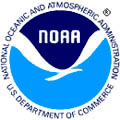 |
Marine User's Manual C. R. Jackson
Sponsored
by the NOAA/NESDIS
|
 |
 |
Marine User's Manual C. R. Jackson
Sponsored
by the NOAA/NESDIS
|
 |
|
The objective of the SAR Marine User's Manual is to lay out, for a wide range of users, the types of information that may be obtained from SAR images of the ocean, and methods of analyzing the imagery. It is intended for non-expert but scientifically literate workers who wish to use synthetic aperture data in their studies but who do not quite know what of make of the data. Spaceborne synthetic aperture radar (SAR) provides
a unique view of the Earths surface. The finely detailed imagery
of the oceans surface from a SAR is assuredly the most complex and least
understood data provided by remote sensing instruments. The sea surface
can appear featureless or contain the signatures of such diverse phenomena
as surface and internal waves, upwelling, current boundaries, shallow water
bathymetry, wind, rainfall, roll vortices, convective cells, storms, and
a wide variety of sea ice forms.
|
Please direct inquiries to editor@sarusersmanual.com |
| TABLE OF CONTENTS | PDF File | |

|
PDG |
|
| Part I. Background | ||

|
|
|

|
|
|

|
|
|
| Part II. Oceanic Measurements | ||

|
|
|

|
|
|

|
2.2 MB |
|

|
|
|

|
|
|

|
|
|

|
|
|

|
|
|

|
|
|
| Part III. Atmospheric Boundary Layer Measurements | ||

|
|
|

|
6.6 MB |
|

|
|
|

|
|
|

|
|
|
| Part IV. Sea Ice Observations | ||

|
|
|

|
|
|

|
39.9 MB |
|
| Appendices | ||

|
|
|

|
|